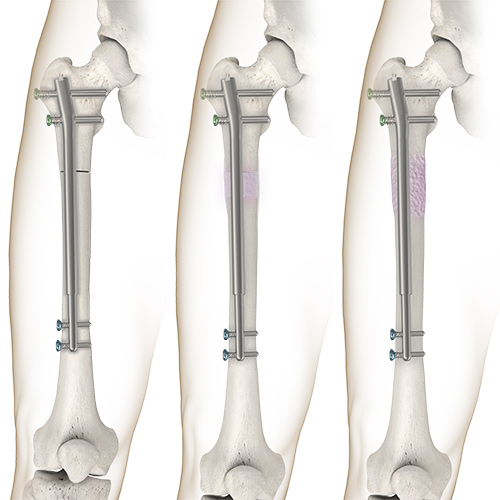What is Limb Lengthening?
The procedure involves clearing a path for the titanium nail, surgically breaking the bone, and then implanting the nail. After the procedure, the lengthening nail is actuated by an external magnetic controller which will gradually separate the bone segments in a controlled fashion. As the bone segments separate, new cells form in the gap as the body tries to heal and eventually solidifies into solid bone.

Principle Behind Leg Lengthening
The process of increasing the bone length depends on tissue and bone regeneration. When the bone is pulled apart, it tends to regenerate at the rate of approximately 1 mm per day.
Phases of Leg Lengthening Procedure
There are two phases of lengthening until the bone is healed:
- The distraction phase involves lengthening of the bone.
- The consolidation phase involves hardening and calcification of this new bone, which is still weak due to lack of calcium.
Limb Lengthening Devices
There are two types of devices available, external fixators and internal fixators. The external devices are attached to the bone with wires or threaded pins. The internal devices are placed inside your body, on the bone or inside the bone marrow.
Limb Lengthening Process
The procedure involves:
- Surgery: During surgery, a small incision is made to gain access to the part of the bone to be cut. A hospital stay of 1-3 days may be required after which rehabilitation and application of splints will be done.
- Distraction Phase: Bone lengthening begins a few days or weeks after the surgery. With the use of external fixators, you or your family member performs small twists by applying pressure on the leg. When the bones are pulled apart, new bone gradually starts to grow between the bone ends. The rate of growth is usually 1 mm per day. X-rays are obtained every 2 to 3 weeks to check for new bone growth, nerve and muscle function, and to avoid any further complications.
- Consolidation Phase: After achieving the required length, all adjustments made to the device are stopped. The newly formed bone is weak and will tend to break without the support of external or internal devices. Lengthening over nails (LON) is used as an external device. This device remains in the bone until the distraction phase. After removal of the LON, an internal rod is placed at the end of the bone for support. The rod hardens the newly formed bone. The function of the internal device automatically stops after reaching the desired length. Bone healing is evaluated with X-rays that are obtained once a month. The X-ray shows the amount of calcium present in the bone. After the bone is healed the rods are removed.
- Removal of the External Fixator: The removal of the external fixator device is done either under general anesthesia or with you awake. After removal, a cast made of plaster of Paris (POP) is placed for a month for protection. No cast is placed for an internal fixator device as the support placed internally protects the bone.
Complications of Limb Lengthening Surgery
Complications can occur when you do not follow the instructions and treatment plan given to you by your physician and healthcare providers. We have made the process for healing easy to follow so you can achieve the best results.
Bone complications include:
- Delayed union or non-union: Bone healing is delayed due to damage of bone tissues at the time of bone cutting.
- Premature consolidation: It occurs when the bone healing is abundant or fast.
- Axial deviation: It occurs because of unbalanced forces that bend the bone during the lengthening process.
Soft tissue complications include:
- Muscle contractures: This occurs when the soft tissues cannot adapt to the changes in bone length.
- Muscle weakness: It is caused by lack of movement because of the inability to walk normally.
- Nerve injury: This occurs when certain nerves do not stretch in coordination with the bone lengthening.
